Family : Labrisomidae

Text © Giuseppe Mazza

English translation by Mario Beltramini
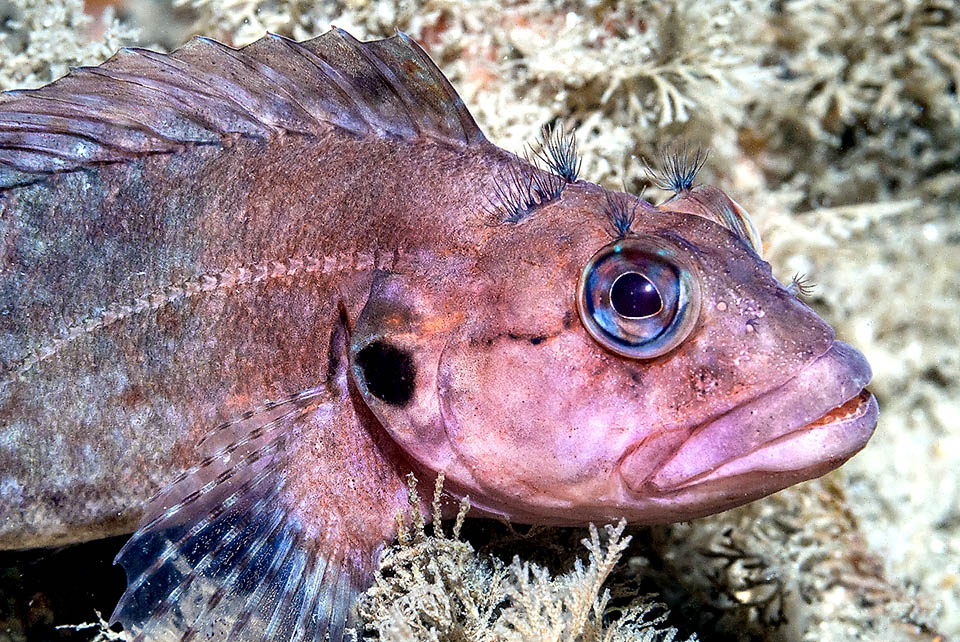
Present on both tropical Atlantic sides, the Hairy blenny (Labrisomus nuchipinnis) surprises for the odd tendrils over the eyes and on the nape evoking hair, the size, the showy lateral line and the scales instead of the usual mucus typical of the Blenniiformes: a protective slime that earned them the vulgar name of blennies © Brian cole
Among the Blenniiformes, that include about one thousand species, are not missing also fish with hairs, like the Hairy blenny, Labrisomus nuchipinnis ( Quoy & Gaimard, 1824 ), inserted in the class of the Actinopterygii, the ray-finned fish, and belonging to the family of the Labrisomidae, counting 15 genera and more than one hundred species of marine and brackish water.
Abnormal blennies, not small and slimy as usually happens, but of good size, complete with scales and lateral line.
The genus Labrisomus, created by Swainson in 1839, seems to refer, with unexplained etymology, to the world of the labrids composing the genus Labrus with the Greek “soma”, body, due to a certain similarity to these fish having showy nuptial liveries.
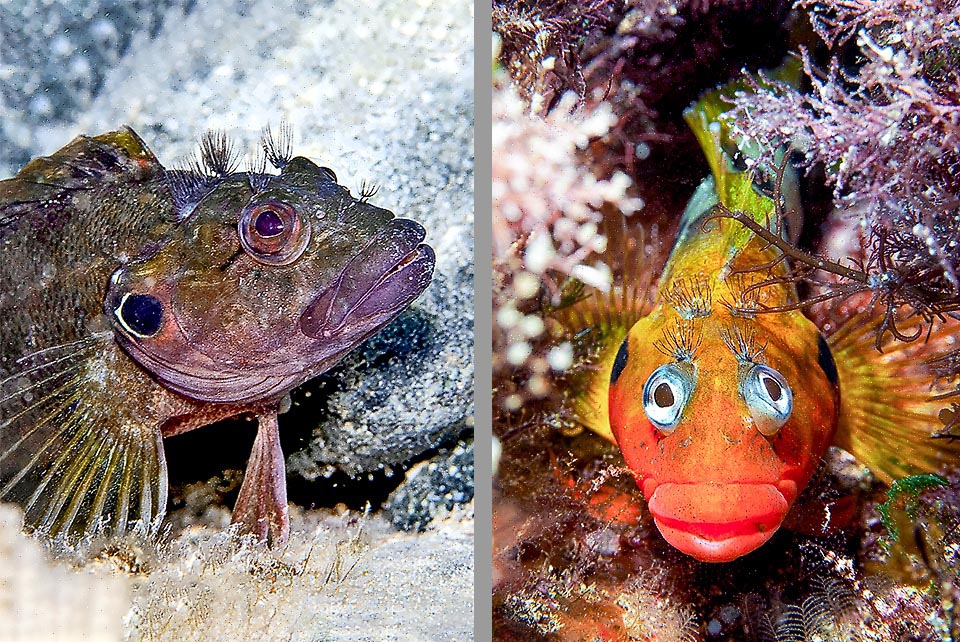
Also here the hairiness is evident and as happens for the genus Labrus fish, from which originates the scientific name Labrisomus, the males nuptial livery is showy © Allison & Carlos Estape (left) © Dennis Rabeling (right)
The specific term nuchipinnis (Quoy & Gaimard 1824) conversely originates composed in Latin by “nucha”, and “pinnis”, fin, with reference to the dorsal fin beginning close to the nape.
Zoogeography
Labrisomus nuchipinnis lives in tropical waters on the two sides of the Atlantic. In America it is found from the Bermudas, Florida, Bahamas and Gulf of northern Mexico up to Rio de Janeiro in Brazil and the facing archipelago of Trindade and Martin Vaz more than 1000 km from the continent.
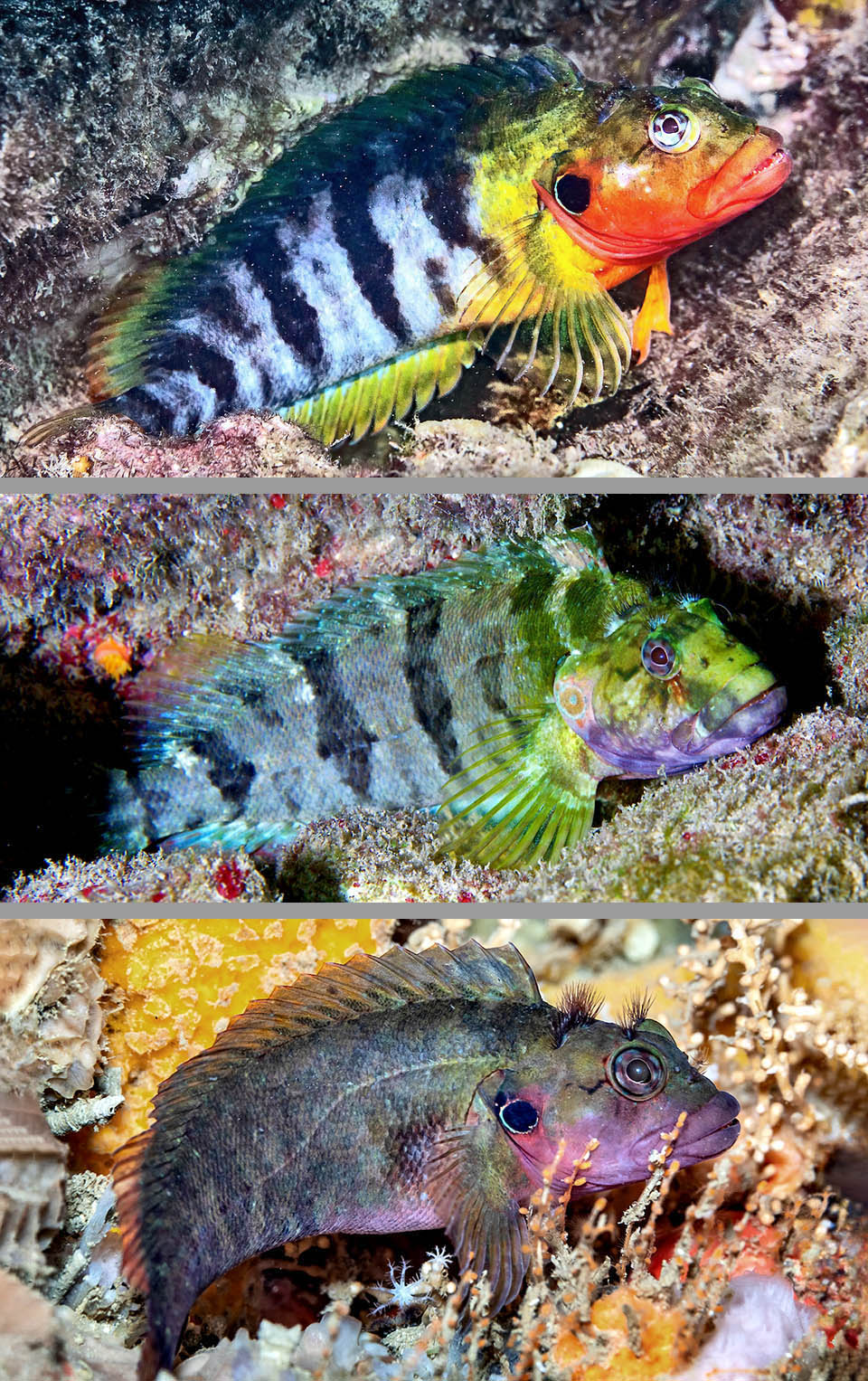
They reach 23 cm of length and can assume, depending on circumstances, all these looks © Allison & Carlos Estape
In the east Atlantic it is finally present in the Canary Islands, Cape Verde, and along the African coast from Senegal to Equatorial Guinea.
Ecology-Habitat
The Hairy blenny is a sedentary diurnal species that may be found on the seabeds between 1 and 10 m of depth, but often frequents shallower waters without descending below 5 m. Usually the juveniles grow up in the tide pools, whilst the adults are found in the submerged prairies of the marine phanerogams or while resting between the rocky and madreporic clefts.
Morphophysiology
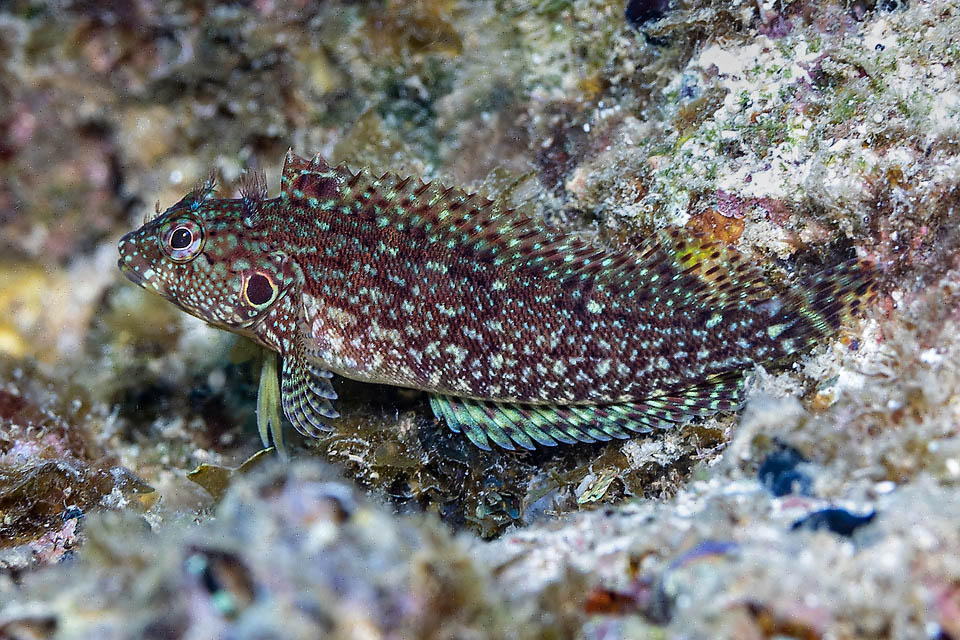
Sexual dimorphism is really remarkable, and apart the opercular ocellus, females are satisfied of this modest livery © Allison & Carlos Estape
With its 23 cm of length and sturdy body, Labrisomus nuchipinnis is the biggest Caribbean Labrisomidae.
The head, broad with blunt snout, has a large, slightly oblique, mouth with fleshy lips.
The teeth, bigger on the upper jaw, are present also on the sides of the palate. The big eyes are surmounted by a showy ramified tendril, similar to a tuft of hair, followed by 2 or more analogous tendrils on the nape. Then there are smaller ones close to the tubular fore nostrils equipped with an apical cover for blocking the possible entrance of sand. The operculum has a characteristic black spot with clear edge and in the adults we note also a dark spot in the fore part of the dorsal fin.
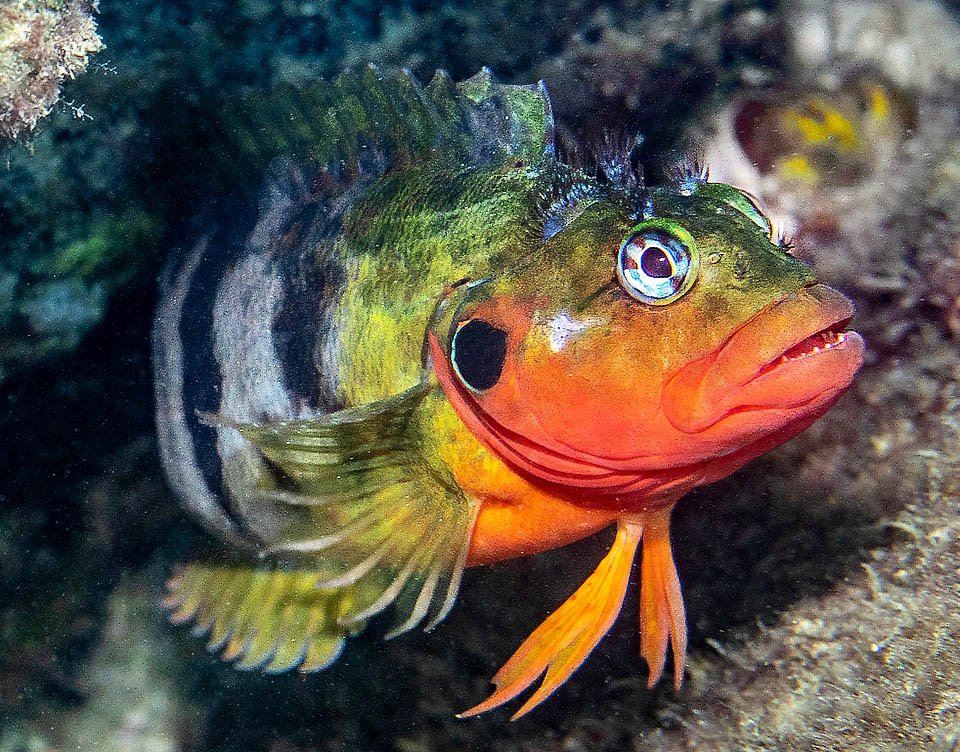
In the reproductive time males choose on the rocks a well exposed and defendable site attracting with their splendour the females ready to spawn © Allison & Carlos Estape
This has 17-20 spiny rays and after a notch only 11-1C3 soft, the opposite of what generally happens in the bony fish, but this is the norm in the family of the Labrisomidae where the dorsal fin has always more spines than the unarmed rays, that sometimes, in some species, may be also missing.
The first anal has 2 spiny rays and 18-19 soft; the pelvic, placed in front of the pectoral ones, have an inner hidden spine and 3 soft rays; the pectoral ones 13-14 rays and the caudal is more or less truncated.
The lateral mine, well evident, counts 64-69 scales.
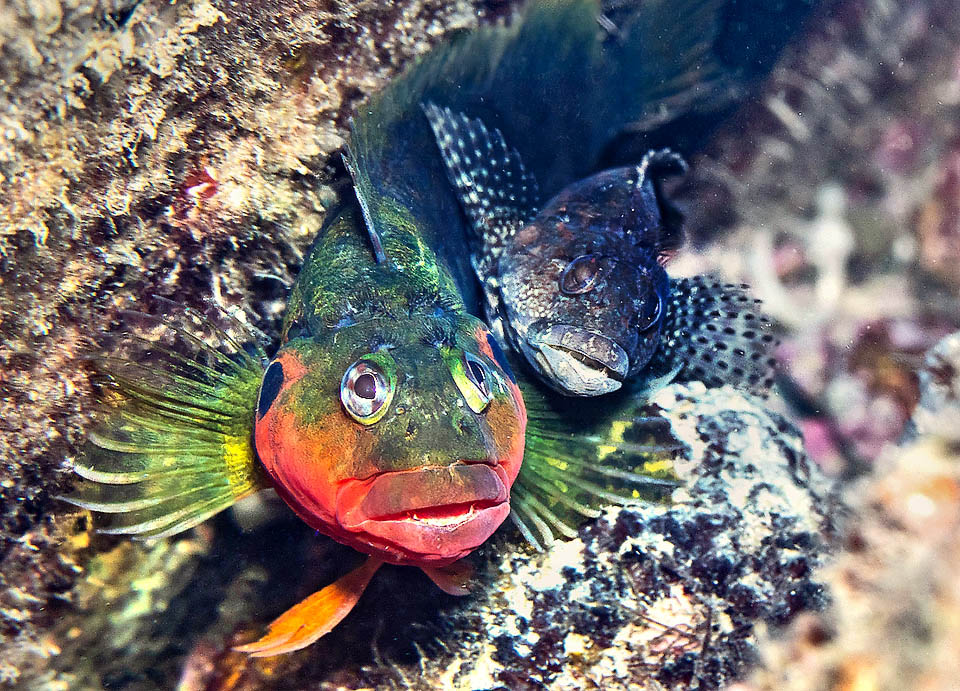
These are the ones taking the initiative, showing their availability to the male by light pushes on the sides © Allison & Carlos Estape
The livery, quite variable depending on the circumstances due to the effect of the chromatophores, presents a strong sexual dimorphism.
The males, with their flaming red throat during the reproductive period, present 5 dark and irregular transversal double bands. The most marked ones descend from the back, spaced by bluish, yellow or greenish zones, but the drawing may fade to the point of almost disappearing and the whole livery then gets very dark tones, almost to black, with at most some magenta-pink nuances in the low part of the head and towards the ventral side.
The females, standing still the opercular ocellus, instead display a very modest livery made of light dots on a dark brown background.
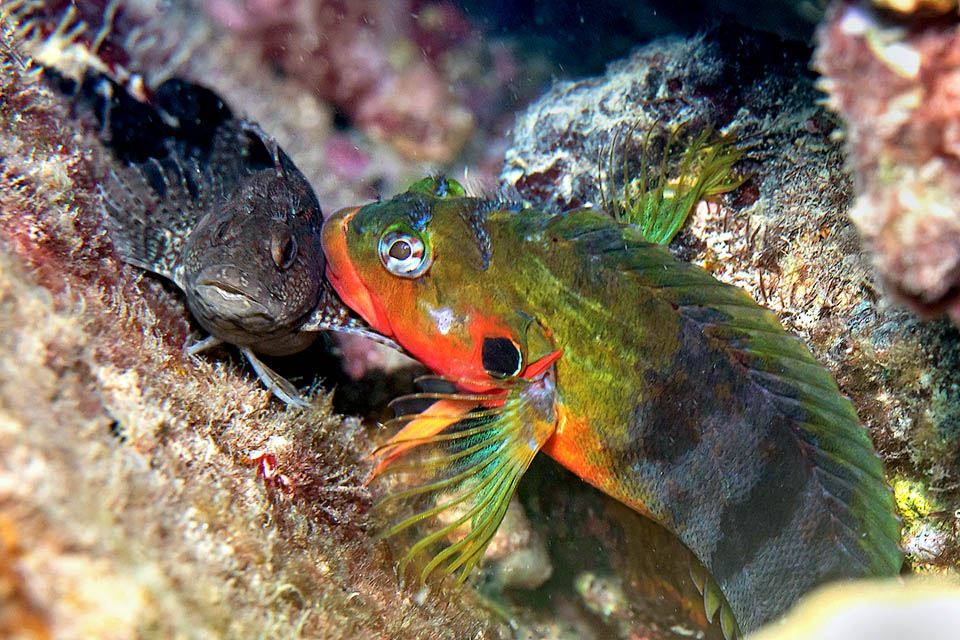
The male does the same leading the female with light taps to the site chosen for the nest © Allison & Carlos Estape
Ethology-Reproductive Biology
Labrisomus nuchipinnis mainly feeds on crustaceans and gastropods, but also on fragile starfish, sea urchins, polychaete worms and some unwary small fish.
For the reproduction the male chooses on a rock the place suitable for the deposition, cleaning it carefully. The females are not long in coming and often take the initiative stimulating the male with small pushes on the sides. He does the same and when the female rubs itself on the chosen spot vibrating by love with the erect tail and banging its tail on the rock, approaches perpendicular its partner biting her on the sides or rubbing her to release the eggs immediately fecundated in a trembling orgasm.
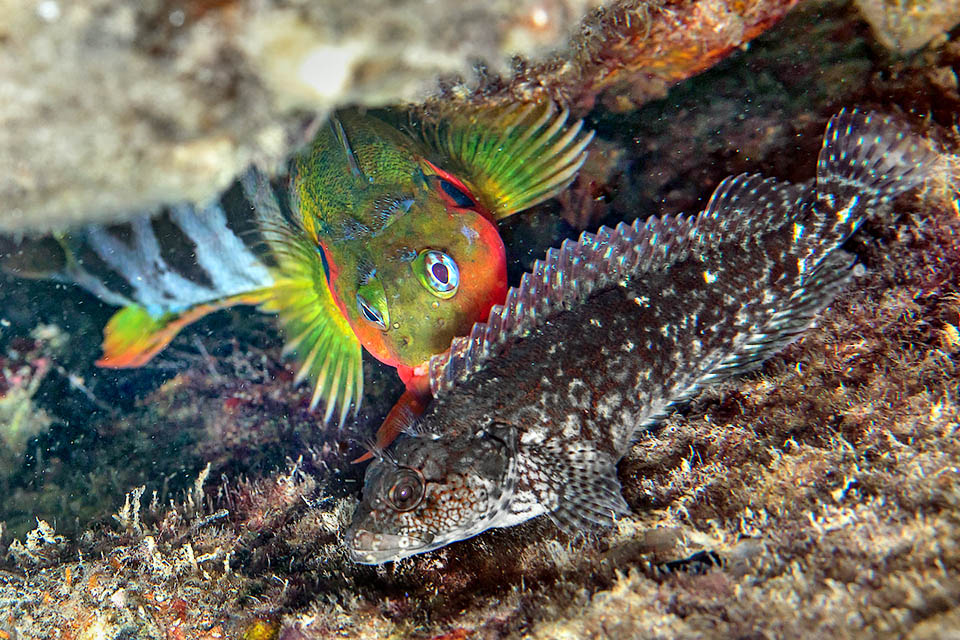
When this one rubs on the chosen rock vibrating with love with its dorsal erect, that’s the signal for the eggs release that he fecundates biting her in a trembling orgasm © Allison & Carlos Estape
It has been noted that the whole cycle lasts just over one minute, and even less if there is a second female waiting.
These after spawning get away while the male surveys the eggs, patrolling the surroundings with a circular swim, until hatching, but ready to repeat the ceremony if another one arrives.
The larvae are pelagic and, carried by the currents, spread the species.
The resilience is mediocre with a minimum doubling time of the populations between 1,4-4,4 years, and the fishing vulnerability, very low, marks only 10 on a scale of 100.
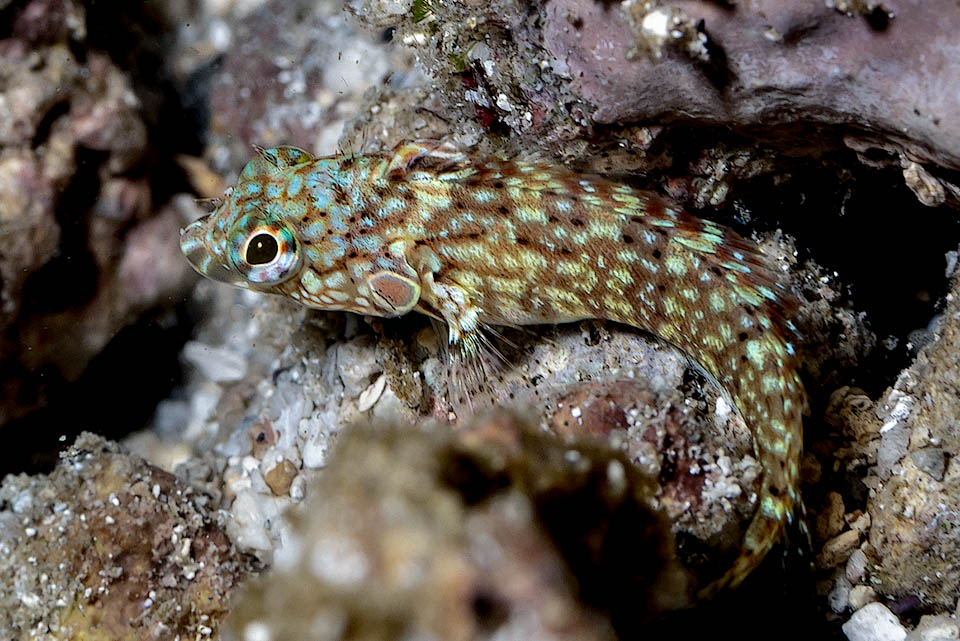
The nest, often with eggs of several females is watched until hatching by the male. Larvae are pelagic and this is a juvenile who has reached the seabeds since time © Allison & Carlos Estape
In fact, it is a theoretically commestible fish, but of little value, sometimes caught for the aquaria or fished with a line for pleasure.
Considering also its vast range, from 2014, Labrisomus nuchipinnis appears consequently as “LC, Least Concern” in the IUCN Red List of the endangered species.
Synonyms
Clinus nuchipinnis Quoy & Gaimard,1824; Clinus pectinifer Valenciennes,1836; Labrisomus pectinifer (Valenciennes,1836); Clinus canariensis Valenciennes,1838; Clinus pedatipennis Rochebrune,1880.
→ For general information about FISH please click here.
→ For general information about BONY FISH please click here
→ For general information about CARTILAGINOUS FISH please click here.
→ To appreciate the BIODIVERSITY of BONY FISH please click here.
→ To appreciate the BIODIVERSITY of CARTILAGINOUS FISH please click here.
